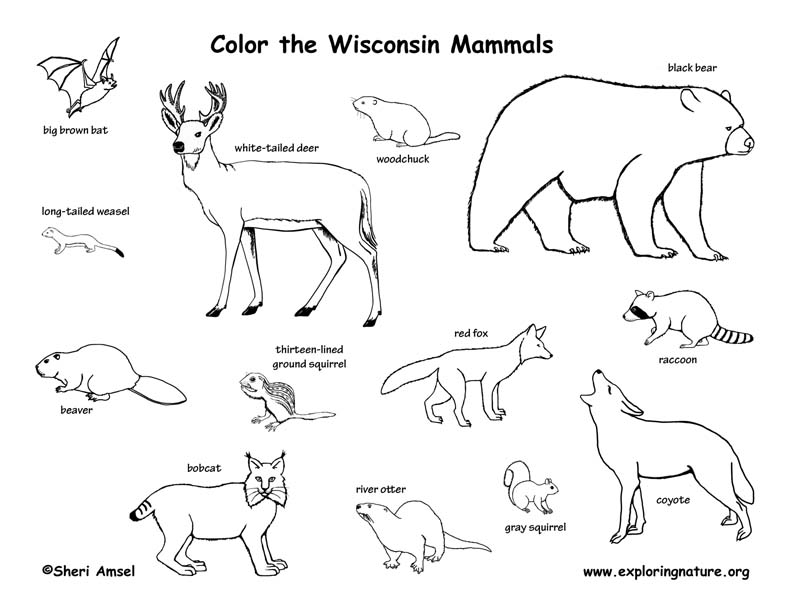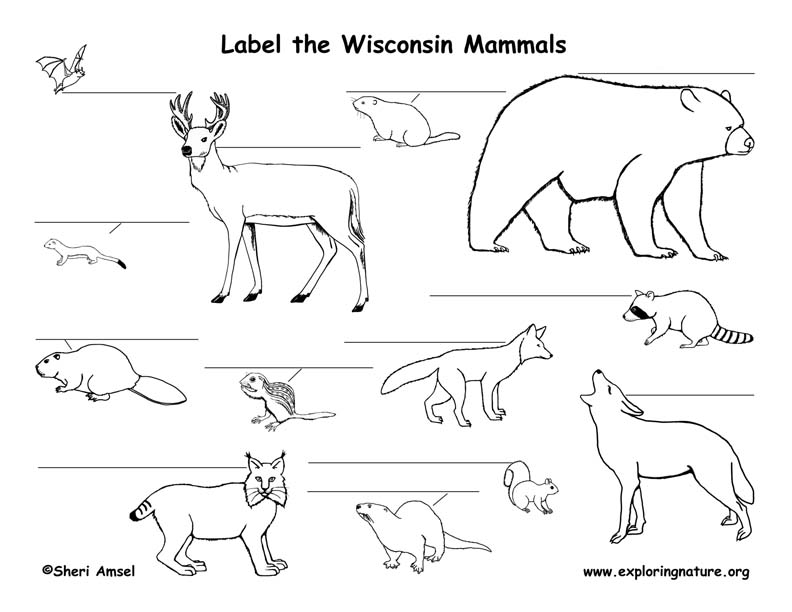

Forest
About 46% of Wisconsin's 34.7 million acres is forest today - that's 16 million acres. Most of Wisconsin's forest was cleared for timber and agriculture in the late 1800s-early 1900s. Northern Wisconsin's forests have come back though few trees are more than 125 years old. Much of southern Wisconsin was developed into farmland after the forests were cleared and in those areas the forests have only regrown in marginal crop and pastureland. Slowly, the state's forests have been coming back and maturing. Today, about 57% of Wisconsin's forests are owned privately while the federal, state, county or tribal governments own 32%. 11% is owned by forest industry or private corporations.
Wisconsin has many kinds of forests. They are located by soil type, climate and elevation. Some examples are northern hardwood forests, bottomland hardwood forests, oak forests, black spruce forests, white cedar forests, jack pine forest, aspen forests, hemlock hardwood forests, fir-spruce forests, and many more. For example, Wisconsin's oak forests (where oaks make up 50% or more of the trees) are found in southern and central Wisconsin on sandy soils. Trees found in these oak forests are red oak, white oak, bur oak and shagbark hickory, red maple, aspens, basswood, paper birch, white pine, and black cherry. Another example are bottomland hardwood forests. These forests are found along rivers and streams. They are more common in southern Wisconsin but are also found in the north. The trees in bottomland hardwood forests in Wisconsin are silver maple, green ash, river birch, swamp white oak, red maple, black willow, cottonwood, and hackberry. Swamp hardwood forest is found around lake shores and in lowland basins. Here the vegetation must tolerate "wet feet" as water levels can fluctuate. Swamp hardwood forest species include red maple, black ash, dogwoods, nannyberry, alder and ferns.
Wetlands
Wetlands are very important habitats. They provide valuable wildlife habitat, stabilize shorelines and protect the land from storm surges and flooding. They act as filters to pollutants that run off the land from farms, towns and cities. Yet, for generations, people saw wetlands as dangerous and wasted land and set about filling them in and covering them over. It wasn't until late in the 1900s that people realized the vital importance of wetlands and set about protecting and reclaiming them. Wisconsin's wetlands include swamps, bogs, muskegs, marshes, wild rice, wetland swales, and wet meadows. Wisconsin also has over 15,000 inland lakes (not including the Great Lakes), thousands of small ponds, and more than 32,932 miles (53,000 kilometers) of rivers and streams. Today, only about 53% of Wisconsin's wetlands remain and they are found mostly in the northern part of the state. Only 36% of the Wisconsin's bogs and swamps are left.
Marshes have plant life that is soft-stemmed and rises out of standing water. These include cattails, grasses, sedges, rushes, arrowhead, pickerel weed, and smartweed. Wisconsin's marshes are found around lakes and along rivers. Marshes are vital habitat - both for feeding and reproducing – for fish, water birds – ducks, geese, herons, cranes, rails, song birds, frogs, reptiles and many mammals (muskrats, beaver, and otter). Wisconsin has both northern and southern sedge marshes. Wisconsin also has wild rice which grows in shallow, slow-moving waters of rivers, streams, and lakes.
Wisconsin's bogs form when ponds fill in with decaying plant matter forming a mat around open water or filling in completely forming a spongy mat of peat covered by sphagnum moss. The acidic environment creates very slowly decomposition of plant matter. For plants to survive in a bog, they must be acid tolerant like mosses, sedges, orchids, sundews, pitcher plants, leather-leaf, bog-laurel, small cranberry, and labrador tea. A muskeg is similar to a bog but muskegs can support more woody vegetation like tamaracks and black spruces.
Grasslands
Almost 2 million acres of tallgrass prairie existed in Wisconsin before European settlement. Less than 10,000 acres are left today and that is dangerously fragmented. This is a common story among all the prairie states where the grasslands were destroyed for agriculture and urban development. Grassland-shrub habitat is important to many birds like bobwhites, flycatchers, shrikes, thrashers, vireos, yellowthroats, sparrows, goldfinch, and blackbirds, northern harriers, short-eared owls, wrens, meadowlarks, and bobolinks.
badger (American)
bat (big brown)
bat (eastern pipistrelle)
bat (hoary)
bat (Indiana)
bat (Keen's myotis)
bat (little brown)
bat (red)
bat (silver-haired)
bear (black)
beaver
bobcat
chipmunk (eastern)
chipmunk (least)
coyote
deer (white-tailed)
fisher
fox (gray)
fox (red)
ground squirrel (Franklin's)
ground squirrel (thirteen-lined)
hare (snowshoe)
jackrabbit (white-tailed)
lemming (southern bog)
lynx (Canadian)
marten (American)
mink (American)
mole (eastern)
mole (star-nosed)
moose
mouse (deer)
mouse (house)
mouse (meadow jumping)
mouse (western harvest)
mouse (white-footed)
mouse (woodland jumping)
muskrat
opossum
otter (river)
pocket gopher (plains)
porcupine (North American)
rabbit (eastern cottontail)
raccoon
rat (brown)
shrew (Arctic)
shrew (cinereus)
shrew (least)
shrew (northern short-tailed)
shrew (pygmy)
shrew (smokey)
shrew (water)
skunk (striped)
squirrel (eastern fox)
squirrel (eastern gray)
squirrel (red)
squirrel (northern flying)
squirrel (southern flying)
vole (meadow)
vole (prairie)
vole (southern red-backed)
vole (woodland)
weasel (least)
weasel (long-tailed)
weasel (short-tailed) or ermine
wolf (gray)
woodchuck
For more information about Wisconsin mammals (including Latin names) click on individual animal links or for another (off-site) resource: LINK
Amphibians
bullfrog
frog (Blanchard's cricket)
frog (green)
frog (mink)
frog (northern cricket)
frog (northern leopard)
frog (pickerel)
frog (western chorus)
frog (wood)
newt (central)
salamanders (blue-spotted)
salamanders (four-toed)
salamanders (mudpuppy)
salamanders (red-backed)
salamanders (spotted)
salamanders (tiger)
spring peeper (northern)
toad (American)
treefrog (Cope's gray)
treefrog (gray)
Reptiles
lizard (prairie racerunner)
lizard (western slender glass)
skink (five-lined)
skink (northern prairie)
snake (black rat)
snake (bullsnake)
snake (Butler's gartersnake)
snake (common gartersnake)
snake (Dekay's brown)
snake (eastern fox)
snake (eastern hog-nosed)
snake (eastern massasauga - rattlesnake)
snake (eastern milk)
snake (eastern racer)
snake (northern ribbon)
snake (northern red-bellied)
snake (northern water)
snake (plains gartersnake)
snake (queen)
snake (ring-necked)
snake (smooth green)
snake (timber rattlesnake)
snake (western ribbonsnake)
turtle (Blanding's)
turtle (common map)
turtle (common musk)
turtle (common snapping)
turtle (eastern spiny soft-shell)
turtle (false map)
turtle (Midland painted)
turtle (Midland smooth softshell)
turtle (ornate box)
turtle (Ouachita map)
turtle (western painted)
turtle (wood)
For more information about Wisconsin amphibians and reptiles (including Latin names) click on individual animal links or for another (off-site) resource: LINK
anhinga
ani (groove-billed)
avocet (American)
bittern (American)
bittern (least)
blackbird (Brewer's)
blackbird (red-winged)
blackbird (rusty)
blackbird (yellow-headed)
bluebird (eastern)
bluebird (mountain)
bobolink
bobwhite (northern)
bunting (indigo)
bunting (lark)
bunting (snow)
cardinal (northern)
catbird (gray)
chat (yellow-breasted)
chickadee (black-capped)
chickadee (boreal)
chuck-will's-widow
Clark's nutcracker
coot (American)
cormorant (double-crested)
cormorant (neotropic)
cowbird (brown-headed)
crane (sandhill)
crane (whooping)
creeper (brown)
crossbill (red)
crossbill (white-winged)
crow (American)
cuckoo (black-billed)
cuckoo (yellow-billed)
curlew (eskimo)
dickcissel
dove (eastern collared-dove)
dove (mourning)
dove (white-winged)
duck (American black)
duck (American wigeon)
duck (Barrow's goldeneye)
duck (black-bellied whistling)
duck (black scoter)
duck (blue-winged teal)
duck (bufflehead)
duck (canvasback)
duck (cinnamon teal)
duck (common eider)
duck (common goldeneye)
duck (Eurasian wigeon)
duck (fulvous whistling)
duck (gadwall)
duck (greater scaup)
duck (green-winged teal)
duck (harlequin)
duck (king eider)
duck (lesser scaup)
duck (long-tailed)
duck (mallard)
duck (masked)
duck (northern pintail)
duck (northern shoveler)
duck (redhead)
duck (ring-necked)
duck (ruddy)
duck (smew)
duck (surf scoter)
duck (white-winged scoter)
duck (wood)
dunlin
eagle (bald)
eagle (golden)
egret (cattle)
egret (great)
egret (snowy)
falcon (peregrine)
finch (house)
finch (purple)
flicker (northern)
flycatcher (Acadian)
flycatcher (alder)
flycatcher (great-crested)
flycatcher (least)
flycatcher (olive-sided)
flycatcher (scissor-tailed)
flycatcher (vermillion)
flycatcher (willow)
flycatcher (yellow-bellied)
frigatebird (magnificent)
gallinule (common)
gallinule (purple)
gnatcatcher (blue-gray)
godwit (Hudsonian)
godwit (marbled)
goldfinch (American)
goose (brant)
goose (cackling)
goose (Canada)
goose (greater white-fronted)
goose (Ross's)
goose (snow)
grackle (common)
grebe (eared)
grebe (horned)
grebe (pied-billed)
grebe (red-necked)
grebe (western)
grosbeak (black-headed)
grosbeak (blue)
grosbeak (evening)
grosbeak (pine)
grosbeak (rose-breasted)
grouse (ruffed)
grouse (sharp-tailed)
grouse (spruce)
gull (black-headed)
gull (black-tailed)
gull (Bonaparte's)
gull (California)
gull (Franklin's)
gull (glaucous)
gull (great black-backed)
gull (herring)
gull (iceland)
gull (laughing)
gull (lesser black-backed)
gull (little)
gull (mew)
gull (ring-billed)
gull (Sabine's)
gull (Thayer's)
gyrfalcon
harrier (northern)
hawk (broad-winged)
hawk (Cooper's)
hawk (ferruginous)
hawk (Harris's)
hawk (northern goshawk)
hawk (red-shouldered)
hawk (red-tailed)
hawk (rough-legged)
hawk (sharp-shinned)
hawk (Swainson's)
heron (black-crowned night)
heron (great blue)
heron (little blue)
heron (green)
heron (tricolored)
heron (yellow-crowned night)
horned lark
hummingbird (ruby-throated)
hummingbird (rufous)
ibis (American white)
ibis (glossy)
ibis (white-faced)
jaeger (long-tailed)
jaeger (parasitic)
jaeger (pomarine)
jay (blue)
jay (gray)
junco (dark-eyed)
kestrel (American)
killdeer
kingbird (eastern)
kingbird (western)
kingfisher (belted)
kinglet (golden-crowned)
kinglet (ruby-crowned)
kite (Mississippi)
kite (swallow-tailed)
kite (white-tailed)
kittiwake (black-legged)
longspur (chestnut-collared)
longspur (Lapland)
longspur (Smith's)
loon (common)
loon (Pacific)
loon (red-throated)
magpie (black-billed)
martin (purple)
meadowlark (eastern)
meadowlark (western)
merganser (common)
merganser (hooded)
merganser (red-breasted)
merlin
mockingbird (northern)
nighthawk (common)
nuthatch (red-breasted)
nuthatch (white-breasted)
oriole (Baltimore)
oriole (Bullock's)
oriole (hooded)
oriole (orchard)
osprey
ovenbird
owl (barn)
owl (barred)
owl (boreal)
owl (burrowing)
owl (eastern screech)
owl (great gray)
owl (great horned)
owl (long-eared)
owl (northern hawk)
owl (northern saw-whet)
owl (short-eared)
owl (snowy)
partridge (grey)
parula (northern)
pelican (American white)
pelican (brown)
phalarope (red)
phalarope (red-necked)
phalarope (Wilson's)
pheasant (ring-necked)
phoebe (eastern)
pigeon (rock)
pine siskin
pipit (American)
phoebe (eastern)
plover (American golden)
plover (black-bellied)
plover (piping)
plover (semipalmated)
plover (snowy)
ptarmigan (willow)
rail (black)
rail (king)
rail (Virginia)
rail (yellow)
raven (common)
red knot
redpoll (common)
redpoll (hoary)
redstart (American)
robin (American)
ruff
sanderling
sandpiper (Baird's)
sandpiper (buff-breasted)
sandpiper (curlew)
sandpiper (least)
sandpiper (pectoral)
sandpiper (purple)
sandpiper (semipalmated)
sandpiper (solitary)
sandpiper (spotted)
sandpiper (stilt)
sandpiper (upland)
sandpiper (western)
sandpiper (white-rumped)
sapsucker (yellow-bellied)
shrike (loggerhead)
shrike (northern)
snipe (common)
solitaire (Townsend's)
sparrow (American tree)
sparrow (Baird's)
sparrow (black-throated)
sparrow (chipping)
sparrow (clay-colored)
sparrow (Eurasian tree)
sparrow (field)
sparrow (fox)
sparrow (grasshopper)
sparrow (golden-crowned)
sparrow (Harris's)
sparrow (Henslow's)
sparrow (house)
sparrow (lark)
sparrow (LeConte's)
sparrow (Lincoln's)
sparrow (Nelson's sharp-tailed)
sparrow (savannah)
sparrow (song)
sparrow (swamp)
sparrow (vesper)
sparrow (white-crowned)
sparrow (white-throated)
spoonbill (roseate)
sora
starling (European)
stilt (black-necked)
stork (wood)
swallow (bank)
swallow (barn)
swallow (cave)
swallow (cliff)
swallow (north rough-winged)
swallow (tree)
swan (mute)
swan (trumpeter)
swan (tundra)
swift (chimney)
tanager (scarlet)
tanager (summer)
tanager (western)
tern (Arctic)
tern (black)
tern (Caspian)
tern (common)
tern (Forster's)
tern (least)
tern (sooty)
tern (white-winged)
towhee (eastern)
towhee (green-tailed)
towhee (spotted)
thrasher (brown)
thrush (gray-cheeked)
thrush (hermit)
thrush (Swainson's)
thrush (wood)
thrush (varied)
titmouse (tufted)
turkey (wild)
turnstone (black)
turnstone (ruddy)
veery
vireo (Bell's)
vireo (blue-headed)
vireo (Philadelphia)
vireo (red-eyed)
vireo (warbling)
vireo (white-eyed)
vireo (yellow-throated)
vulture (black)
vulture (turkey)
warbler (black and white)
warbler (Blackburnian)
warbler (blackpoll)
warbler (black-throated blue)
warbler (bay-breasted)
warbler (black and white)
warbler (blue-winged)
warbler (black-throated green)
warbler (Canada)
warbler (Cape May)
warbler (cerulean)
warbler (chestnut-sided)
warbler (Connecticut)
warbler (golden-winged)
warbler (hooded)
warbler (Kentucky)
warbler (Kirtland's)
warbler (MacGillivray's)
warbler (magnolia)
warbler (mourning)
warbler (Nashville)
warbler (orange-crowned)
warbler (palm)
warbler (pine)
warbler (prairie)
warbler (prothonotary)
warbler (Tennessee)
warbler (Wilson's)
warbler (worm-eating)
warbler (yellow)
warbler (yellow-rumped)
warbler (yellow-throated)
waterthrush (Louisiana)
waterthrush (northern)
waxwing (Bohemian)
waxwing (cedar)
whimbrel
whip-poor-will (eastern)
willet
woodcock (American)
woodpecker (American three-toed)
woodpecker (black-backed)
woodpecker (downy)
woodpecker (hairy)
woodpecker (pileated)
woodpecker (red-bellied)
woodpecker (red-headed)
wood-pewee (eastern)
wren (Carolina)
wren (house)
wren (marsh)
wren (rock)
wren (sedge)
wren (winter)
yellowlegs (greater)
yellowlegs (lesser)
yellowthroat (common)
When you research information you must cite the reference. Citing for websites is different from citing from books, magazines and periodicals. The style of citing shown here is from the MLA Style Citations (Modern Language Association).
When citing a WEBSITE the general format is as follows.
Author Last Name, First Name(s). "Title: Subtitle of Part of Web Page, if appropriate." Title: Subtitle: Section of Page if appropriate. Sponsoring/Publishing Agency, If Given. Additional significant descriptive information. Date of Electronic Publication or other Date, such as Last Updated. Day Month Year of access < URL >.
Amsel, Sheri. "Wisconsin Habitats, Mammals, Birds, Amphibians, Reptiles" Exploring Nature Educational Resource ©2005-2024. December 14, 2024
< http://www.exploringnature.org/db/view/Wisconsin-Habitats-Mammals-Birds-Amphibians-Reptiles >








